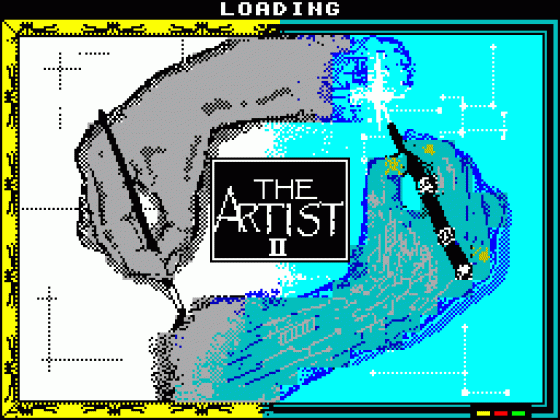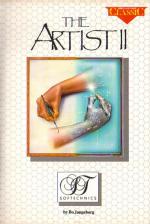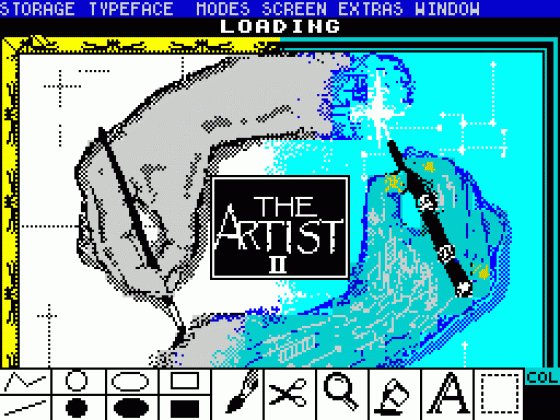
ZX Computing
 1st February 1987
1st February 1987
Categories: Review: Software
Publisher: Softechnics
Machine: Spectrum 48K/128K
Published in ZX Computing #34
Both The Artist and Art Studio are re-released this month in enhanced versions, but are the improvements worth having?
The Artist II
I have mixed feelings about this program. It could - and should have been by far the best package of its type available for the Spectrum, but it seems to have been rushed on to the market without enough checking, and a handful of bugs have been allowed to take the edge off it. Some of them are just irritating things which don't matter too much - the storage menus are the wrong way round, so you have to select 'tape' to use Microdrive and vice versa; if you move the screen up to work on the part normally hidden by the icon menus, you have to scroll the screen after some options, because the bottom three lines are transferred to the top when you return to the normal viewing screen. But some other problems are much more serious. The SAVE/LOAD operations do not work when you are using the design font option. SAVE stores the wrong block of memory, and LOAD crashes the program! I have managed to find a way of getting round this (see footnote), but the deficiencies in the printing facilities have defeated me so far.
The handbook says that the program will drive an Opus disc drive centronics interface or Kempston E. I am told that there are no problems with Opus, but with my Kempston E, only the greyscale screen dumps would work. The ordinary screen dumps and the Pagemaker printing option simply produced the required number of line feeds but no printing. It is especially galling to use the Pagemaker, an exciting facility which allows you to produce an illustrated A4 page, combining text produced by Softechnics' word processor, The Writer, with graphics produced by The Artist II. There you are, with your beautiful illustrated page on screen, and because the print option doesn't work, you can't get it on to paper.
And Yet...
But, despite the bugs, this is still a very powerful package. Developed from Softechnics' earlier success, The Artist, it now supports Microdrive, Opus disc or tape storage, keyboard or Kempston joystick, Kempston or AMX mice for control. The layout has been completely redesigned, and now has easy-to-use pull-down and icon menus. I am sorry to see that the facility to draw an arc between two points is no longer with us, and that the keyboard cursor control keys are still letter keys rather than the arrows, but the extra facilities the program now has are tremendous. There are now elastic lines, circles, ellipses or rectangles, and shapes can be drawn in outline or ready-filled with the chosen texture. There are 28 textures available, and all are redefinable and can be saved or loaded. The fill option is as efficient as ever, and the enlarge option, for detailed work, far better than in the old program. The enlarged window is shown alongside the same area in normal size so that the effect of changes can be seen as you work.

For lettering, the program comes with five fonts. These are redefinable, but you would be well advised to confine your modifications to fonts 3, 4 and 5. Font 1 is the Spectrum character set, and being held in ROM, ignores all your attempts to modify it, though the font designer gives the impression that you are making changes. Font 2, the small typeface, is used extensively by the program. I discovered the hard way - the handbook does not warn you - that inverting it makes the menu cursors invisible and mirroring it makes the menus unreadable. It was virtually impossible to get back to normal without reloading the program.
Cut 'N Paste
The window and the cut and paste options are the program's great strength. A rectangular window of any size (corresponding to the character squares) can be defined anywhere on screen and the area within it cleared, moved, enlarged or compressed, rotated, inverted or mirrored. The design can be thickened or outlined, attributes changed or the image scrolled. Cut and paste has some of these facilities, but any size or shape of area can be manipulated and, whereas the window option only allows portions to be moved in character-square jumps, the scroll option in cut and paste allows placement to pixel accuracy. Both window and cut and paste have an insert mode which allows a second screen to be loaded, and portions of it cut and inserted into the current artwork. The ship in the illustration was cut from one of the demo screens supplied with the earlier Artist program, and inserted into the seascape drawn with this one. This is a very powerful facility, allowing you to build up a screen library and bring bits and pieces of several screens together in a new one.
There is now a separate sprite designer, which has normal sized and enlarged screens upon which sprites up to 6 x 6 character squares can be designed. They can also be 'grabbed' from existing screens and inserted into the present one. Sprites for animation can be designed and stored in a sequential file - up to 79 screens 3 x 3 square size, less for larger. To test animation, the speed and frame numbers are selected and the animation is demonstrated on the normal size screen. Sprite files can be saved with their frame information - for reloading into the designer - or as a string of bytes for use in other programs.
Is The Artist II a good buy? Well... if you have an Opus disc drive or are not particularly interested in screen dumps, yes. You will not find a better or more powerful screen art program than this one. But if, like me, you use screen dumps a lot you might find it disappointing. I would like to think that Softechnics will do some more work on it and issue a Mark 2 version without the bugs, driving the interfaces it is supposed to drive, and with a better handbook than it now has. The present one is rather sketchy - you almost have to read between the lines to discover the full potential of some of the program's options - and it has too many printing errors. Dare I also suggest that a free tape exchange for those who bought this flawed version would be a nice gesture? But certainly, Softechnics should take another look at it. It is far too good a program to be left in the state it is now.
Footnote
To save and load type fonts.
Select the save/load option and give the filename when prompted. Use the BREAK key to return to BASIC. (Do not start the tape if saving.) Enter as a direct command:
LET B=number
number=62268 for font 3
61500 for font 4
63036 for font 5
Now enter GO TO
72 to load from microdrive/disc
74 to load from tape
82 to save to microdrive/disc
84 to save to tape
Proceed as usual to save/load
Other Reviews Of The Artist II For The Spectrum 48K/128K
The Artist II (Softechnics)
A review by Franco Frey (Crash)
The Artist II (SofTechnics)
A review by Phil South (Your Sinclair)
Return Of The Artist
Carol Brooksbank reviews the new 128K version of Artist II, and the debugged 48K
The Artist II (Softechnics)
A review by Graham Taylor (Sinclair User)



